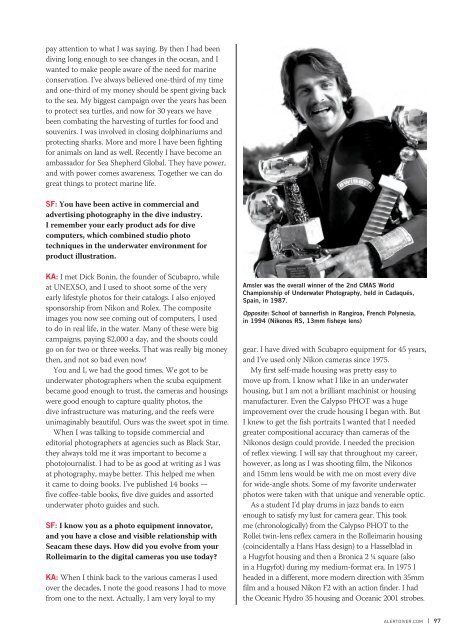AD 2016 Q3
Alert Diver is the dive industry’s leading publication. Featuring DAN’s core content of dive safety, research, education and medical information, each issue is a must-read reference, archived and shared by passionate scuba enthusiasts. In addition, Alert Diver showcases fascinating dive destinations and marine environmental topics through images from the world’s greatest underwater photographers and stories from the most experienced and eloquent dive journalists in the business.
Alert Diver is the dive industry’s leading publication. Featuring DAN’s core content of dive safety, research, education and medical information, each issue is a must-read reference, archived and shared by passionate scuba enthusiasts. In addition, Alert Diver showcases fascinating dive destinations and marine environmental topics through images from the world’s greatest underwater photographers and stories from the most experienced and eloquent dive journalists in the business.
You also want an ePaper? Increase the reach of your titles
YUMPU automatically turns print PDFs into web optimized ePapers that Google loves.
pay attention to what I was saying. By then I had been<br />
diving long enough to see changes in the ocean, and I<br />
wanted to make people aware of the need for marine<br />
conservation. I’ve always believed one-third of my time<br />
and one-third of my money should be spent giving back<br />
to the sea. My biggest campaign over the years has been<br />
to protect sea turtles, and now for 30 years we have<br />
been combating the harvesting of turtles for food and<br />
souvenirs. I was involved in closing dolphinariums and<br />
protecting sharks. More and more I have been fighting<br />
for animals on land as well. Recently I have become an<br />
ambassador for Sea Shepherd Global. They have power,<br />
and with power comes awareness. Together we can do<br />
great things to protect marine life.<br />
SF: You have been active in commercial and<br />
advertising photography in the dive industry.<br />
I remember your early product ads for dive<br />
computers, which combined studio photo<br />
techniques in the underwater environment for<br />
product illustration.<br />
KA: I met Dick Bonin, the founder of Scubapro, while<br />
at UNEXSO, and I used to shoot some of the very<br />
early lifestyle photos for their catalogs. I also enjoyed<br />
sponsorship from Nikon and Rolex. The composite<br />
images you now see coming out of computers, I used<br />
to do in real life, in the water. Many of these were big<br />
campaigns, paying $2,000 a day, and the shoots could<br />
go on for two or three weeks. That was really big money<br />
then, and not so bad even now!<br />
You and I, we had the good times. We got to be<br />
underwater photographers when the scuba equipment<br />
became good enough to trust, the cameras and housings<br />
were good enough to capture quality photos, the<br />
dive infrastructure was maturing, and the reefs were<br />
unimaginably beautiful. Ours was the sweet spot in time.<br />
When I was talking to topside commercial and<br />
editorial photographers at agencies such as Black Star,<br />
they always told me it was important to become a<br />
photojournalist. I had to be as good at writing as I was<br />
at photography, maybe better. This helped me when<br />
it came to doing books. I’ve published 14 books —<br />
five coffee-table books, five dive guides and assorted<br />
underwater photo guides and such.<br />
SF: I know you as a photo equipment innovator,<br />
and you have a close and visible relationship with<br />
Seacam these days. How did you evolve from your<br />
Rolleimarin to the digital cameras you use today?<br />
KA: When I think back to the various cameras I used<br />
over the decades, I note the good reasons I had to move<br />
from one to the next. Actually, I am very loyal to my<br />
Amsler was the overall winner of the 2nd CMAS World<br />
Championship of Underwater Photography, held in Cadaqués,<br />
Spain, in 1987.<br />
Opposite: School of bannerfish in Rangiroa, French Polynesia,<br />
in 1994 (Nikonos RS, 13mm fisheye lens)<br />
gear. I have dived with Scubapro equipment for 45 years,<br />
and I’ve used only Nikon cameras since 1975.<br />
My first self-made housing was pretty easy to<br />
move up from. I know what I like in an underwater<br />
housing, but I am not a brilliant machinist or housing<br />
manufacturer. Even the Calypso PHOT was a huge<br />
improvement over the crude housing I began with. But<br />
I knew to get the fish portraits I wanted that I needed<br />
greater compositional accuracy than cameras of the<br />
Nikonos design could provide. I needed the precision<br />
of reflex viewing. I will say that throughout my career,<br />
however, as long as I was shooting film, the Nikonos<br />
and 15mm lens would be with me on most every dive<br />
for wide-angle shots. Some of my favorite underwater<br />
photos were taken with that unique and venerable optic.<br />
As a student I’d play drums in jazz bands to earn<br />
enough to satisfy my lust for camera gear. This took<br />
me (chronologically) from the Calypso PHOT to the<br />
Rollei twin-lens reflex camera in the Rolleimarin housing<br />
(coincidentally a Hans Hass design) to a Hasselblad in<br />
a Hugyfot housing and then a Bronica 2 ¼ square (also<br />
in a Hugyfot) during my medium-format era. In 1975 I<br />
headed in a different, more modern direction with 35mm<br />
film and a housed Nikon F2 with an action finder. I had<br />
the Oceanic Hydro 35 housing and Oceanic 2001 strobes.<br />
ALERTDIVER.COM | 97









